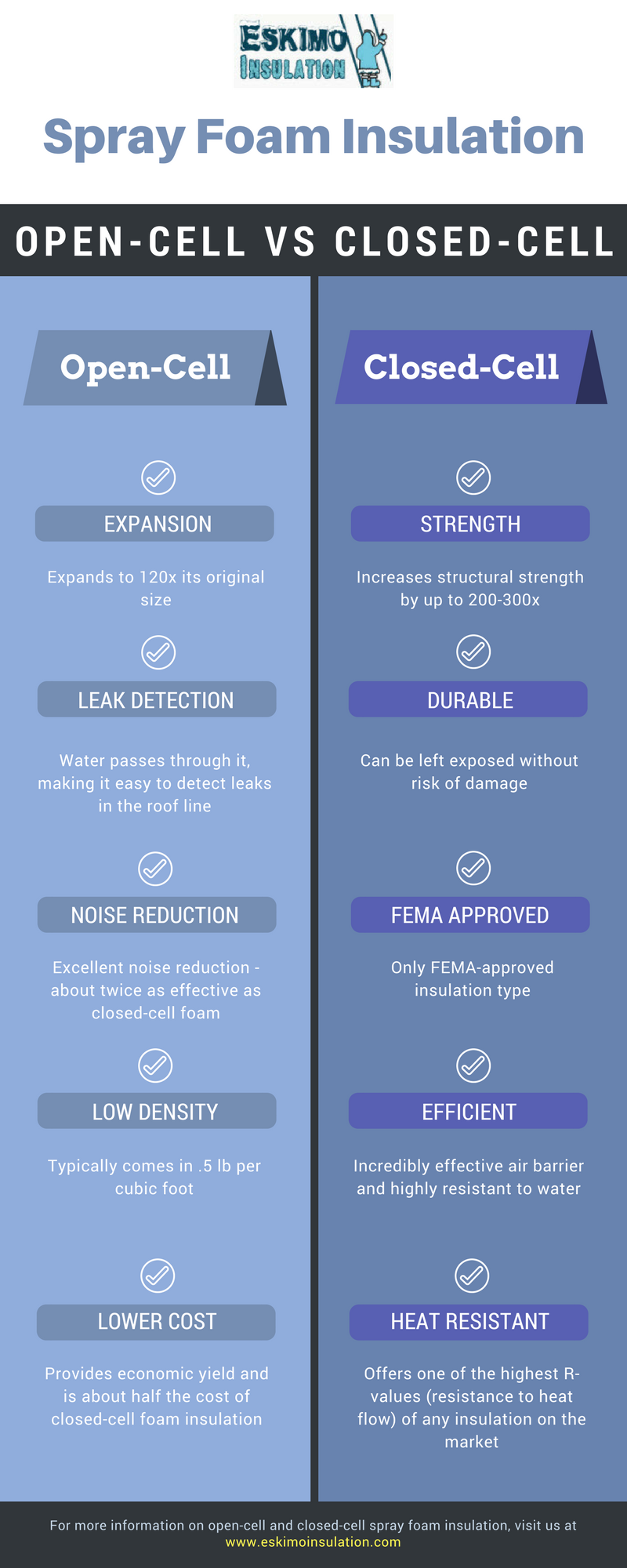Open Cell vs. Closed Cell Spray Foam Insulation: Which One Is Best For My Home?

Suppose you’ve decided to use spray foam insulation in your home or business. In that case, you’ve already made the easy decision to save money on energy costs while blocking out exterior allergens and noise. The next decision might require more thought: open-cell vs. closed-cell spray foam insulation.
Open-cell and closed-cell spray foam provide insulation but accomplish the job differently. The choice between the two depends entirely on your insulation goals.
Differences Between Open Cell and Closed Cell Foam
Open-cell and closed-cell foam are two different types of spray foam insulation. Before you choose a foam type, you should think about which foam will meet your needs.
The Basics
Open-cell spray foam is lighter, less dense, and expands over 100 times its size, making it an excellent option for filling in gaps and cracks. However, it has a lower R-value per inch (resistance to heat flow) than closed-cell foam. Closed-cell spray foam offers a higher R-value per inch thanks to its density. It is more rigid and expands up to 33 times its size.
Open-cell foam is primarily used on walls to provide insulation and a sound barrier between rooms. Closed-cell foam is more prevalent in metal buildings that are left exposed or in shipping containers.
Benefits of Closed Cell Foam Insulation
- Provides robust insulation
- Great in small spaces
- Adds to the structural integrity of the building
- Vapor barrier
- Unharmed by water
Benefits of Open Cell Foam Insulation
- Large expansion
- Insulates hard-to-reach areas
- Excellent soundproofing
- More affordable
- Fills cracks and gaps
Read on to learn more about the differences between open and closed-cell foam.
The Details
The cells
Spray foam is referred to as open or closed cells because of the difference in cell bubbles that make up the foam. Open cell foam consists of cells that are more like a bubble with air inside. These cells are left open, making the foam softer and more flexible. Closed cell foam is made of cells with no space inside. The cells press tightly so air and moisture cannot enter the foam. This type of foam is more rigid.
Density
Closed-cell foam is much denser than open-cell foam. Open-cell foam has a density of about .5 pounds per cubic foot. Closed cell foam can be over three times that, with a density of 1.75 pounds per cubic foot or more. The lighter density of open-cell foam means it performs much better than closed-cell when soundproofing.
R-values
A foam’s R-value is its resistance to heat flow or how well it insulates. Closed-cell spray foam has a higher R-value per inch than open cell, with an R-value of between 6 to 7 per inch, while open cell has an R-value ranging from 3.5 to 3.6 per inch. However, because open-celled foams offer better expansion, filling in cracks and gaps, the two types of foam are virtually identical regarding thermal protection.
Expansion
Open-cell foam expands over 100 times its size, while closed-cell foam only expands about 33 times. Closed-cell foam is designed to grow to 1” thick when sprayed. With each application, a higher total R-value is achieved. Open-cell foam expands to 3” wide, so typically, only one application is possible.
Choosing: Closed Cell vs. Open Cell Foam Insulation
- Remember your foam insulation goals
- Insulation
- Moisture barrier
- Soundproofing
- Consider where the foam will be applied
- Walls
- Exterior
- Roof/attic
- Know your budget – closed cell is more than two times the cost per R-value
Whatever you choose – closed cell or open cell – Eskimo Insulation has the experience and expertise to quickly apply spray foam insulation in your home or commercial building.
An Overview of Closed-Cell Spray Foam Insulation
Closed-cell spray foam insulation is highly efficient. This structural insulation makes for an incredibly effective air barrier, and its low moisture vapor permeability makes it highly water-resistant. Its density is typically 2 lbs/cu.ft. The closed-cell foam also offers one of the highest R-values (resistance to heat flow) of any insulation on the market.
A few other essential features of closed-cell insulation include:
- Increases structural strength by up to 200-300x
- Can be left exposed without risk of damage
- Only FEMA-approved insulation
Typical applications for closed-cell insulation include wine rooms, metal buildings, containers, and cold floors.
Contact us today to learn more about open-cell vs. closed-cell spray foam insulation!
Request A Quote Review Us On Google
